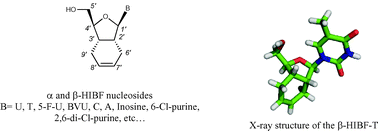Synthesis and anti-HIV activity of conformationally restricted bicyclic hexahydroisobenzofuran nucleoside analogs†
Abstract
A chiral synthesis of a series of

* Corresponding authors
a
Departamento de Química Orgánica e Inorgánica and Instituto Universitario de Biotecnología de Asturias, Universidad de Oviedo, 33006-Oviedo (Asturias), Spain
E-mail:
vgs@uniovi.es
Fax: (+34) 98-510-3448
b
Department of Chemistry and Biochemistry, University of California, San Diego, 9500 Gilman Drive, La Jolla, CA 92093-0358, USA
E-mail:
etheodor@ucsd.edu
c Rasayan Inc., 2802 Crystal Ridge Road, Encinitas, CA 92024-6615, USA
d Emory University School of Medicine/Veterans Affair Medical Center, Atlanta, Georgia 30033, USA
A chiral synthesis of a series of

 Please wait while we load your content...
Something went wrong. Try again?
Please wait while we load your content...
Something went wrong. Try again?
A. Díaz-Rodríguez, Y. S. Sanghvi, S. Fernández, R. F. Schinazi, E. A. Theodorakis, M. Ferrero and V. Gotor, Org. Biomol. Chem., 2009, 7, 1415 DOI: 10.1039/B818707J
To request permission to reproduce material from this article, please go to the Copyright Clearance Center request page.
If you are an author contributing to an RSC publication, you do not need to request permission provided correct acknowledgement is given.
If you are the author of this article, you do not need to request permission to reproduce figures and diagrams provided correct acknowledgement is given. If you want to reproduce the whole article in a third-party publication (excluding your thesis/dissertation for which permission is not required) please go to the Copyright Clearance Center request page.
Read more about how to correctly acknowledge RSC content.
 Fetching data from CrossRef.
Fetching data from CrossRef.
This may take some time to load.
Loading related content
